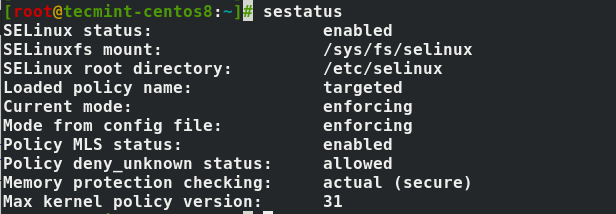SELinux or Security-Enhanced Linux is a mechanism or security module that provides access control security policies. In simple terms, it’s a feature or service used for restricting users to certain policies and rules set by the systems administrator.
In this topic, you will learn how to disable SELinux temporarily and later permanently on CentOS 8 Linux.
On this page
How to Temporarily Disable SELinux on CentOS 8
Before you start disabling SELinux on CentOS 8, it’s prudent that you first check the status of SELinux.
To do so, run the command:
# sestatus

This shows that SELinux is up and running.
To temporarily disable SELinux run the command.
# setenforce 0
Also, you can run the command.
# setenforce Permissive
Either of these commands will temporarily disable SELinux only until the next reboot.
How to Permanently Disable SELinux on CentOS 8
Now, let’s see how we can permanently disable SELinux. The configuration file for SElinux is located at /etc/selinux/config. Therefore, we need to make a few modifications to the file.
# vi /etc/selinux/config
Set the SELinux attribute to disabled as shown below:
SELINUX=disabled

Save and exit the configuration file and reboot your CentOS 8 Linux system using any of the commands below.
# reboot # init 0 # telinit 0
Now check the status of SELinux using the command.
# sestatus

SELinux is a very crucial feature on CentOS 8 and helps in restricting unauthorized users from accessing certain services on the system.
In this guide, we demonstrated how you can disable SELinux on CentOS 8. Ideally, it’s always recommended to keep SELinux enabled with the exception of instances where you are configuring services that require SELinux to be disabled.
We hope you found this guide insightful. And that’s all for today. Your feedback is most welcome.






